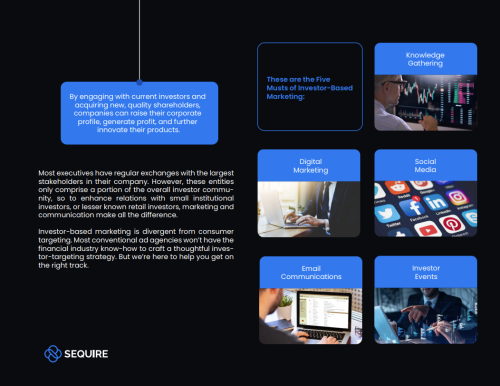Not using multimedia content risks falling behind the trend
Let’s all try to relax because this is a safe space to explore and come to terms with all that multimedia content and digital stress. You’re with other IR professionals here and everything is going to be okay.
Actually, shall we dump the cloying, newfangled language? It could get annoying. You may, however, want to take a few deep breaths because getting your head around the world of multimedia financial releases is bewildering for the uninitiated.
For starters, there’s the sheer range of social media tools available to you, each with those almost but not quite familiar names: Twitter, Delicious, Technorati, Flickr. And then there’s the stunningly fast click-and-skim immediacy of it all.
Samantha Proctor, director of multimedia content marketing communications for Europe, Middle East and Africa at PR Newswire, says the company has promoted multimedia news content releases for six years and investors are increasingly catching up with the technology. ‘Lots of people are watching video on the internet – many respond better to pictures and images than text,’ she explains. ‘Plus, you can put documents and any content you like out there to increase the chances of your story being picked up.’
PR Newswire provides clients with a standard template they can then customize with their own branding and include as much content as they want. One sector using multimedia press releases to great effect, says Proctor, is the healthcare industry. ‘It puts out a lot of information around new drugs to market, including patient studies,’ she notes. ‘The multimedia medium’s ideal because it can show how new drugs or medical devices work rather than just describe them.’
It’s good to recycle
Just think about that: thousands of would-be investors watching detailed, unrelenting updates about in-depth new cosmetic surgery or cardiovascular improvements on their iPhones. But it’s this kind of 21st century online connectivity that can bring your company story suddenly and vividly alive to thousands, be they analysts, investors or consumers.
If you can use a telephone and write a PowerPoint presentation (although not necessarily at the same time), then you can produce a multimedia press release. Creating your own release simply involves collecting the tools you already have and recycling them, assures Monika Maeckle, vice president of new media at Business Wire. ‘It’s an evolution, not a revolution, and a release typically starts with a hyperlink connected to some content on your website,’ she explains. ‘Links can include photos: if you’re quoting your CEO, why not have a snap? Or you can include a link to an audio conference call.’
But doesn’t all this sound rather time-consuming? ‘You’ve already spent the time and the money creating these things,’ says Maeckle. ‘Why not use them?’
Before you start to think about assembling the various pieces of multimedia content you need, however, know what you want to accomplish with it, cautions Mike Nowlan, president and CEO of Marketwire. That may sound blindingly obvious but many multimedia tools have power way beyond their diminutive-sounding name and your message needs to be loaded with care.
Target practice
‘The target audience is critical,’ Nowlan points out. ‘Is it a retail or institutional audience? Because the multimedia content for each will be different. It doesn’t matter what tools you have, it’s about your core message and its value to your core audience.
‘How do you distribute it effectively so that your audience sees it? How do you get to your critical influencers and engage with them? It means you have to be more strategic and flexible, understand your various audiences and adapt your approach.’
Multimedia content is certainly working for Laura Graves, director of global IR at Cisco Systems. The networking equipment company began to use multimedia in its financial press releases in earnest during the last year, says Graves.
‘Pictures and video allow for tone and inflection and, in the end, we believe this makes for a stronger relationship between our company, investors and journalists,’ she continues.
‘Many times when you put out a release, the press is ethically required to reprint the quotation exactly as given. It often takes liberties with headlines, however, and many times we find the newly rendered headline doesn’t reflect the position of our company. By using multimedia, it increases the chance of reporters understanding our key messages.’
Transmitting key messages is certainly needed when you’re mining for hard-to-discover uranium in Guyana’s far-flung Roraima Basin. Nancy Chan-Palmateer is vice president of IR at U3O8 Corp, a Canadian natural mining company tapping into the growing demand for clean nuclear power from this remote part of South America. ‘We’re communicating very technical information a lot of the time,’ she explains.
‘Using a handful of images helps: they can show investors precisely where we’re drilling and how it fits into the bigger investor picture. Not everyone has been to Guyana or knows the terrain. It’s very jungle-like. But multimedia content allows us to show the extent of our operations.
‘Hyperlinks in our releases drive traffic back to our website. They also enable information to be shared very easily with others, with multiple channels.’ (See Social media and SEO, below.)
Multiple channels include technology like Twitter. People are searching Twitter just like they are searching Google, says Maeckle. ‘If they search for news on your company on Twitter and you have spoon-fed the content you want them to see, then you are directly influencing the conversation and the participants’ view of your company and its news.’
Another source says that, at first, he thought Twitter would quickly prove to be a passing fancy, ‘but in fact it’s such a simple tool and a Tweet can be anything you want. You can’t just sit there and understand this technology without actually doing it yourself, however.’
Right-click for exposure
But how do you measure all this improvement in exposure? One IRO admits that gauging this is difficult. ‘It’s still the million-dollar question for us and probably for others,’ he says.
As social media technology becomes more common, however, telling a story through videos and pictures will become more widely accepted, predicts Adam Parker, CEO of UK company RealWire. And as it becomes more accepted, it becomes more effective; even if you don’t have a captive audience you are, at least, creating the opportunity to communicate better.
‘Companies are becoming more confident in this technology where they have a strong motivation to be, so the more your brand is affected by technology, the more you need to address it,’ comments Parker. ‘Maybe that’s why governments and politicians haven’t really addressed it yet, because the motivation needs to be at a profit level. Consumer-facing brands are embracing these things more because they’re an imperative.’
Disseminating your news, then, is changing. It’s also about trust. In the current financial climate many companies have lost that, while conversations, often online, continue about them. Do you want to be part of that conversation, or would you prefer to avoid it? Let’s take those few deep breaths again, shall we? It’s all going to be fine.
Social media and SEO
Increasingly, companies are using social media and search engine optimization (SEO) to push their message to a larger audience online.
A key part of this is making content available to share. You may have noticed ‘Share this’ boxes appearing on press releases next to a host of social media icons, like the Facebook and Twitter logos. These buttons allow the press release to be shared by users across the selected social media sites instantaneously. Another way to share is to make content, such as photos and streaming video, available for others to embed on their websites and blogs.
SEO, on the other hand, improves the visibility of your press release on search engines. Search engines prioritize their findings if they contain particular words or phrases popular with web users. Placing certain key words in your press release thus pushes it higher up the search results.
‘It’s important to have a fairly small set of key words for each press release,’ notes Jeff Stacey, managing director of NASDAQ’s GlobeNewswire. ‘If you’re a large organization you can have a large collection of key words but in any given press release you only want to use two or three. It’s also important to use anchor text in the press release: if you incorporate your key words into anchor text, it makes them stand out.’
Google provides tools to help you work out which key words are being used to search for your company, adds Stacey.
Outreach on a budget
Wire service companies generally provide an effective service for a cost. There’s a DIY option for corporates in these cash-strapped times, however. Why not simply use your own website?
This is the suggestion of Dominic Jones from IR Web Report. The best approach, he says, is to post your multimedia content release on your own website and notify all your email, RSS, SMS, Twitter and Facebook subscribers. ‘If you don’t have a lot of subscribers, use a traditional wire service to send out a short alert advising the market the multimedia release is available on the company’s website and provide a link to it in the alert,’ Jones advises.
This, he says, ensures faster delivery of the information and also gives the company direct control over the quality of delivery, as well as the means to measure the level of interest in it.
‘It further ensures any links to the release go to the company’s website rather than myriad other sites,’ Jones says. ‘Links to a company’s website are critical to prominence in search engines, which means the release on the company’s website will get even more exposure.’










